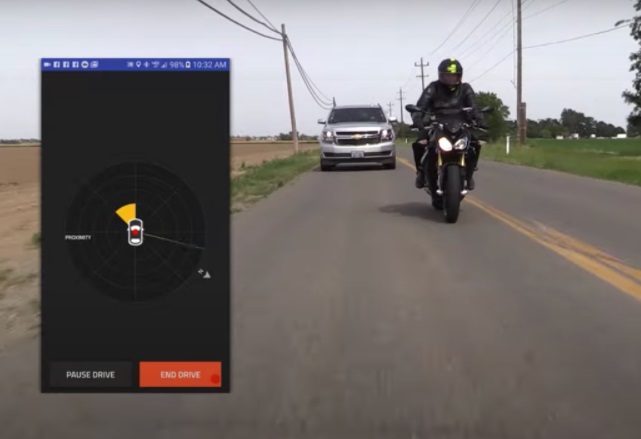Ridar Systems and HERE Technologies have will integrate HERE location technology into Ridar’s cloud-based mobile solution to better identify the location of two-wheelers and provide a more accurate position to drivers. Now, motorcycles, bicycles, scooters and other forms of two-wheeled micro mobility will have a means of announcing their presence to much larger vehicles in order to prevent accidents between the two using only a smartphone.

Current connected car technologies such as DSRC/ IEEE802.11P (vehicle to vehicle using Dedicated Short-Range Communication) or C-V2X (cellular vehicle to everything) for automobiles to communicate directly with other similarly-equipped vehicles. These will provide prompts directly to the driver in the case of connected vehicles or directly to the autonomous vehicle. With either technology, these solutions exclude two-wheelers. The Ridar/HERE partnership could start a path towards such inclusion.
How It Works
Drivers: Ridar runs in the background and verbally notifies the driver when a rider is approximately 5 seconds from that driver’s location. Depending upon how the technology has been registered by the rider, the driver will receive the following notification: “Bicycle Ahead”, “Motorcycle to the Right”, “Bicycles to the Left”, etc.
Riders: Ridar acts as a beacon to all drivers. It warns drivers of potential or imminent collisions keeping riders safe by eliminating blind spots and unnoticed riders. It can also map routes and give crucial ride data. When traveling in groups, Ridar Systems will notify the driver when there are more than one bicycle or motorcycle traveling together.
Ridar Systems will build upon HERE location solutions to power the Ridar Systems cloud-based platform. Within the new agreement, Ridar will be using HERE JavaScript API’s, HERE Routing & Map Rendering, as well as HERE Live Sense SDK and HERE SDK, to enable and manage the driver and rider app services.
“Ridar’s cloud-based mobile solution can predict interactions with a level of accuracy as to when and where a driver and rider might interact. By incorporating HERE’s location solutions, we can predict such interactions with an even higher level of accuracy based upon real-time location data,” said CEO Brent Massey.
“Eventually, we anticipate integrating our solution into OEMs IVI as well as shared micro mobility transportation.”
Ridar System customers will benefit from a suite of advanced location technology available on the HERE platform, including:
- HERE Positioning – HD GNSS Positioning and Network Positioning provides location accuracy. This information is critical to identifying the location of micro-mobility vehicles in dense urban canyons where the GPS signal is weak or inconsistent.
- HERE Live Sense SDK – An AI-based perception model, utilizing optical cameras on smartphones, dashcams, personal navigation devices and vehicles to provide real-time awareness of the environment. This functionality can identify micro-mobility riders and alert automobile drivers, or it can be used to provide those drivers with safety alerts such as potholes, road obstructions, etc.
- HERE Routing – Customized route calculations provide drivers and riders turn-by-turn navigation instructions taking into account different route types based on vehicle type.
- HERE SDK – Provides users advanced location services and customize maps to support drivers & riders with a look back on their route when their drive/ride completed (how many miles, average speed, shareable map of ride). Adding to that, Ridar will also include how many times a driver has detected a rider and vice versa.

